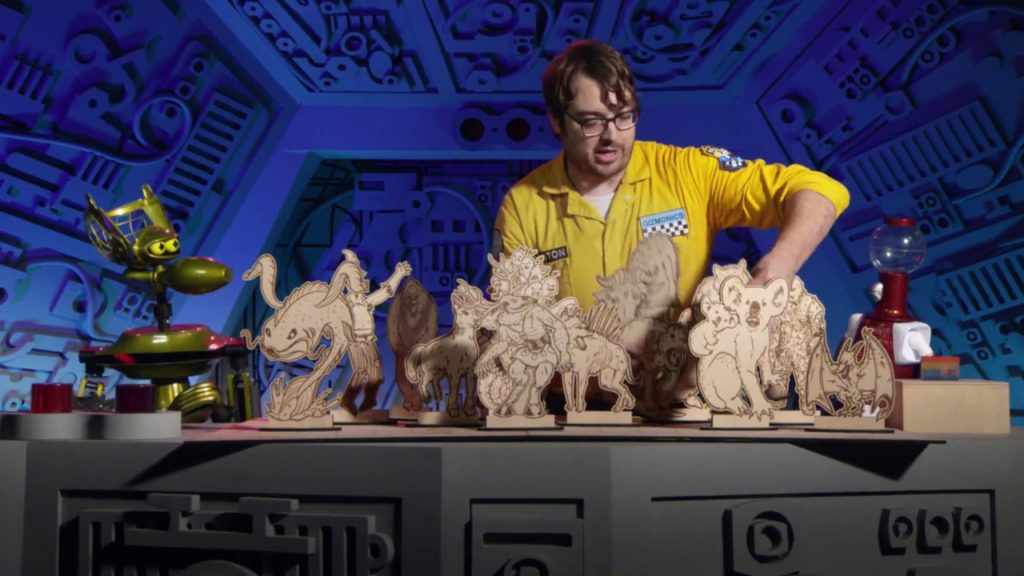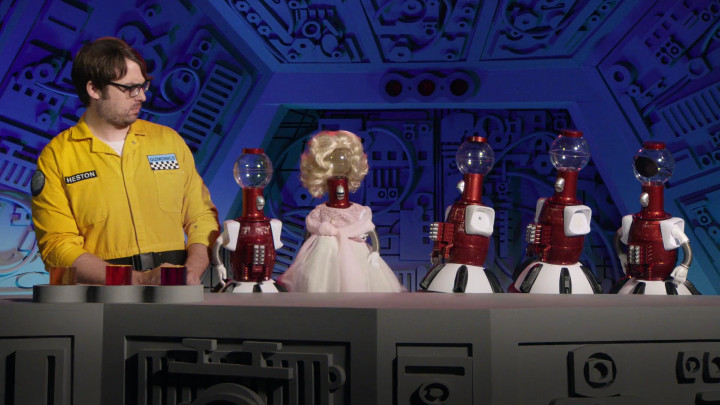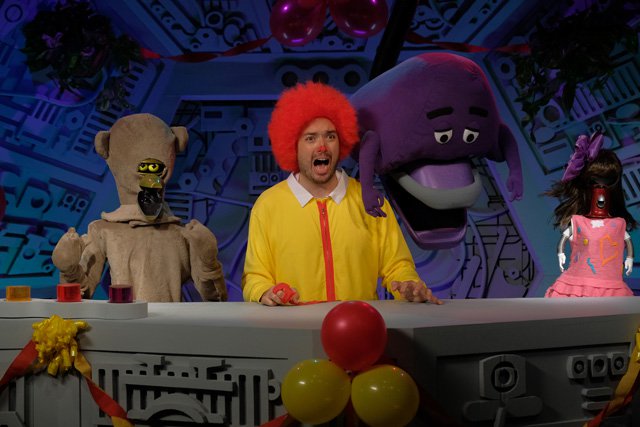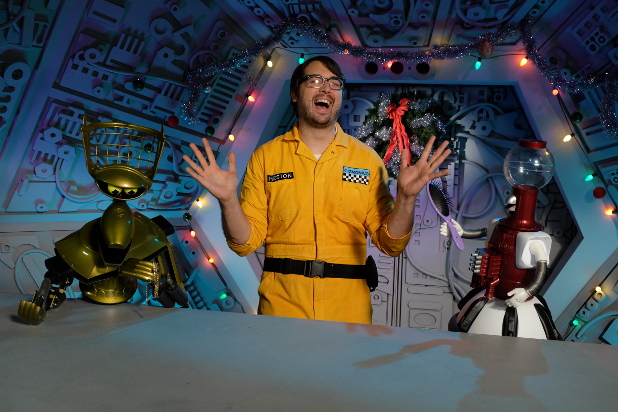It’s a Turkey Day miracle! Mystery Science Theater 3000 returned to Netflix this Thanksgiving with the six-episode series “The Gauntlet.” Challenged to a riffing marathon by the Mads at Moon 13, Jonah and the ‘bots take on six films. Mac & Me, Killer Fish, and more create the basis of a “binge made to be binge watched” spectacular.
As with last season, the tenants of the Satellite of Love mail it. Maybe it’s the firm, slightly silly hand of show creator Joel Hodgson. Maybe it’s the talented cast who themselves grew up on the unique series. But whatever the reason, MST3K retains a special honor: it is one of the few revivals to just plain get it right.
We live in a time of awkward revivals and unasked-for remakes. And yet, this little Twin Cities puppet show is still running strong. How did it survive the jump to the 21st century, and what could other shows trying to make their return learn from it? I’m so glad you asked, because after running The Gauntlet, that’s all I want to talk about.
Find the Heart

In the era of computer animation, it’s tempting to “pretty up” older products. And, well, MST3K did not have a big budget. But it made the most of what it had, lampshading its use of miniatures and creating lovable robots out of bubble gum machines.
So, what did they do with their stack of Netflix money? They didn’t make nicer minis, if that’s what you’re thinking. And it’s a good thing.
Modern MST3K uses modern tech for very specific things—mostly sight gags. They make Tom Servo fly for in-theater visual jokes. They create the tube that, at the start of every episode, pipes Jonah to a simulation where he re-enacts the show’s opening. Once in a while you’ll get some extra pretties (the end of “The Gauntlet” has a wild, spoilery visual that looks great with modern CG), but other than that, it looks like the old days.
That isn’t to say that modern remakes shouldn’t improve upon their predecessors’ tech. But the makers of MST3K knew that its charm was its status as a homemade-feeling prop comedy show. Other things could change—format, actors, what have you—but the look is what’s always complemented the writing. A higher-end Satellite of Love wouldn’t be the same.
Evaluate What’s “Sacred”

This may sound like the exact opposite of what I said above. In actuality, though, it goes hand-in-hand with the previous idea. Many shows, especially geek properties, tend to have elements that we consider “sacred.” The problem is, we are often wrong in our evaluation.
Just as we need to find the heart of the show, we also need to ask ourselves which parts can bend. More ‘bots than the four in our Robot Roll Call may seem wrong, but adding some recurring robots allows for more types of skits. Adding story arcs seems very un-MST, but has become one of the most exciting parts of the show.
Creators need to ask themselves why they consider certain things beyond touching if they’re not core to the essence of the project. And then maybe, just maybe, nudge it a li’l.
Living in the Future is a Chance for More Fun

One thing we see in a lot of modern takes on older work is the idea that they’ll “do better” this time. And sure, sometimes that’s a thing. But when we burden ourselves with “fixing” the original in the follow-up, we run the risk of overwriting.
If there are content or casting issues, that’s one thing. But for the most part, a modern iteration should be seen as an opportunity to play with more ideas. Maybe it’s ideas had since then. Or new philosophies in the world around us. Maybe, as with MST3K, it’s more a matter of having new material to work with that didn’t exist 20 years prior. Either way, we should see the modern aspect as an opportunity, not a burden.
Observe the Tribute Threshold

When you know and love a show, sometimes the temptation is to load down the reboot with as many call-backs as possible. And that’s fine… but only to a point.
A sequel or remake heavy with nods and winks is no longer a show in itself, but a fan tribute. Can you do them? Absolutely. It’s even easier if there’s a way to integrate previous canon while still making your show something new and interesting.
But despite the sheer amount of MST3K in-jokes available for use, the new series uses them sparingly—about as much as the first run referenced itself. A song at the end of “The Gaunlet” references the early episodes’ (arguably) beloved Hamdingers. There are plenty of in-theater nods to previous experiments. The first live tour was even called the Watch Out for Snakes Tour, in honor of a stray line from perennial favorite Eegah. But the tributes never get so heavy that you aren’t interfacing regularly with new material.
Anyone can reference an old classic for two hours; it takes a good writer to know how many is too many.
Format Awareness

We watch things very differently from how we watched them 20, 10, or even 5 years ago. Streaming entertainment is standard, binge-watching is A Thing, and even our movie theater experiences are evolving. And when the audience experience changes, the show itself needs to—at least to some degree.
MST3K goes all in, integrating the concept of streaming movies and Netflix marathons into their actual format. Kinga Forrester, picking up Dr. Clayton Forrester’s experiments, is well aware of audience behavior in 2018. And so, she mods her father’s work for the streaming generation, complete with story arcs and binge-worthy content.
Granted, it’s not always good to be that on the nose. Addressing modern customs head-on is better suited to comedic and self-aware shows. But it’s still important to know that the TV-viewing audience of 2018 isn’t the TV-viewing audience of 1970. Movie watchers aren’t what they were 20 years ago, either. And that’s not a judgment call; societal taste and behavior changes. So you can’t, say, make a sequel to a 1983 movie geared to a 1983 audience. Well, you could, but it might not go well.
Preserving the feel of a vintage property while adapting it for a modern audience is a difficult feat only a few will ever manage. (Super 8 is on that very short list.) All the more reason that it’s so important, rather than clinging to an old style, to let the show feel around in new styles.
The short version of all this is that MST3K knows what it’s doing. It’s a well-run show with an extremely tight, talented creative team behind it. Everything fell into place, at latest, when Jonah’s Kaiju Rap started up in their Reptilicus episode. It was the same series with new faces. It paid homage to the original, but allowed itself to explore new jokes. And it kept its heart while still knowing where it could afford to experiment.
It’s unlikely that any sequel, remake, reboot, or continuation will ever stick the landing this well again. But we can hope.


Comments are closed.